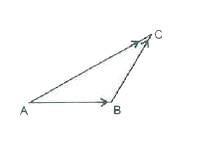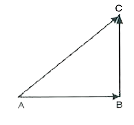For △ABC , which of the following is incorrect ?
(BC−AB)<AC
(AC−BC)<AB
(AC−AB)<BC
None of these
To determine which statement is incorrect regarding triangle ABC, we will evaluate the given options based on the triangle inequality theorem. The triangle inequality theorem states that the sum of the lengths of any two sides of a triangle must be greater than the length of the third side.
1. Identify the Triangle Inequality Conditions:
For triangle ABC with sides AB, BC, and AC, the following conditions must hold true:
- AB + BC > AC
- AB + AC > BC
- AC + BC > AB
2. Evaluate Each Option:
We will analyze each of the given options to see if they hold true according to the triangle inequality.
- Option 1: BC - AB < AC
- Rearranging gives us: BC < AC + AB
- This is true because AB + BC > AC (from the triangle inequality).
- Option 2: AC - BC < AB
- Rearranging gives us: AC < AB + BC
- This is also true because AB + BC > AC (from the triangle inequality).
- Option 3: AC - AB < BC
- Rearranging gives us: AC < AB + BC
- This is again true because AB + BC > AC (from the triangle inequality).
- Option 4: None of these are incorrect.
- Since all the previous options (1, 2, and 3) are correct according to the triangle inequality, this statement is also true.
3. Conclusion:
Since all the options provided are correct, the answer to the question "which of the following is incorrect?" is that none of the given options are incorrect.
Final Answer:
None of the given options are incorrect.
For triangle ABC with sides AB, BC, and AC, the following conditions must hold true:
- AB + BC > AC
- AB + AC > BC
- AC + BC > AB
We will analyze each of the given options to see if they hold true according to the triangle inequality.
- Rearranging gives us: BC < AC + AB
- This is true because AB + BC > AC (from the triangle inequality).
- Rearranging gives us: AC < AB + BC
- This is also true because AB + BC > AC (from the triangle inequality).
- Rearranging gives us: AC < AB + BC
- This is again true because AB + BC > AC (from the triangle inequality).
- Since all the previous options (1, 2, and 3) are correct according to the triangle inequality, this statement is also true.
Since all the options provided are correct, the answer to the question "which of the following is incorrect?" is that none of the given options are incorrect.
None of the given options are incorrect.
Similar Questions
Knowledge Check
In triangle ABC, which of the following is not true :
 A−−→AB+−−→BC+−−→CA=→0B−−→AB+−−→BC−−−→AC=→0C−−→AB+−−→BC−−−→CA=→0D−−→AB−−−→CB+−−→CA=→0
A−−→AB+−−→BC+−−→CA=→0B−−→AB+−−→BC−−−→AC=→0C−−→AB+−−→BC−−−→CA=→0D−−→AB−−−→CB+−−→CA=→0Consider the two similar triangles ABC and DEF. Which of the following is correct about the ratio of the area of the triangle ABCandDEF ?
A(ABDE)=(EFBC)=(ACDF)B(ABDE)2=(BCEF)2=(ACDF)2C(ABDE)=(BCEF)=(DFAC)DNone of theseConsider the two similar triangles ABC and DEF. Which of the following is correct about the ratio of the area of the triangle ABCandDEF ?
A(ABDE)=(EFBC)=(ACDF)B(ABDE)2=(BCEF)2=(ACDF)2C(ABDE)=(BCEF)=(DFAC)DNone of these
For finding the area of a triangle ABC, which of the following entities are required ?
View SolutionIf the ortho-centre of a triangle ABC is B then which of the following is true?
View SolutionIf AB, BC and AC be the three sides of a triangle ABC, then which one of the following is true?
View SolutionIn △ABCand△DFE,AB=FD,∠A=∠D . The which of the following is correct ?
View SolutionIn a triangle ABC, a = 2b and ∠A=3∠B. Which one of the following is correct ?
View Solution

